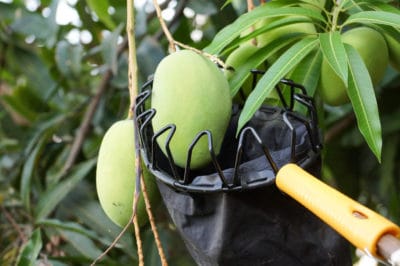Mango Classification Based on Ripening Stage
With over 500 named cultivars, there are quite a few mango varieties to choose from, though you will most likely only locate types that grow well in your particular region. Depending on the cultivar and your climate, mango fruits generally ripen and are ready for harvesting sometime between May and September, though some types may ripen earlier or a bit later.
Based on when the fruit is ripe, mangos are classified as early, mid-season and late-season. As expected, an early-season variety is ripe earlier than a late-season type. Some cultivars based on their season of expected ripeness are listed below.
Early-Season Mango Cultivars
- ‘Angie,’ generally ripe in April to May, good fruit production, produces yellow, orange and pink fruits.
- ‘Rosigold,’ generally ripe in March and April, fair fruit production, produces yellow and red fruits.
- ‘Florigon,’ generally ripe in May and June, good fruit production, produces yellow fruits.
- ‘Saigon,’ generally ripe in May and June, good fruit production, produces green and yellow fruits.
Expert Tip: Mango fruits are ripe and ready to harvest in anywhere from 100 to 150 days after the tree flowers.
Mid-Season Mango Cultivars
- ‘Irwin,’ generally ripe in June and July, good fruit production, produces red fruits.
- ‘Hayden,’ generally ripe in June and July, fair fruit production, produces red and yellow fruits.
- ‘Lippens,’ generally ripe in June and July, good fruit production, produces pink and yellow fruits.
- ‘Fairchild,’ generally ripe in June and July, good fruit production, produces green and yellow fruits.
Late-Season Mango Cultivars
- ‘Neelum,’ generally ripe in September or October, good to fair fruit production, yellow fruits.
- ‘Keitt,’ generally ripe in August or September, good fruit production, produces green, pink and yellow fruits.
- ‘Rapoza,’ generally ripe in July or August, good fruit production, produces yellow and red fruits.
- ‘Valencia Pride,’ generally ripe in July and August, good fruit production, produces yellow, pink and red fruits.
Mango Signs of Ripeness
Mangos ripen on the tree and you don’t have to pick them all at one time. This allows you to harvest the mangos as you are ready to eat them. However, if ripe fruit are left on the tree too long, they will eventually drop to the ground. Depending on the cultivar, mango fruits weigh anywhere from several ounces to several pounds.
You can also harvest the mangos once they are mature but still firm. Bring them indoors and allow them to ripen out of the refrigerator. The skin becomes a bit softer and the mangos achieve full ripeness in anywhere from several days to a week. Once they become ripe, you can store the mangos in the refrigerator.
Tell-tale signs of mango ripeness include:
- Both ends of the mango fill out.
- Multicolored varieties take on their blush of color or change from green to yellow.
- The inner flesh next to the seed changes from white to yellow.
Expert Tips: The outer skin of the mango is inedible and you only consume the inner flesh, which depending on variety, can be yellow or a deep orange color when ripe.
Harvesting the Mangos
Mango fruit should easily pull from the tree, or you can cut each one off with pruning snips. If you are dealing with a large tree where you can’t easily reach the ripe fruits, you can use a pole harvester with an attached basket to remove the ripe mangos. Some people are allergic to the sap so you might wear gloves when harvesting.
Once harvested, wash the ripe fruit to remove the sap. The sap causes black spots on the mangos and leads to rot.
